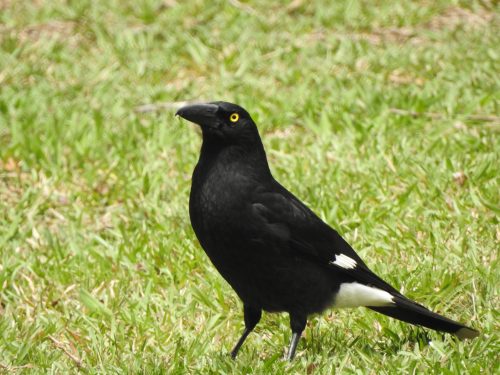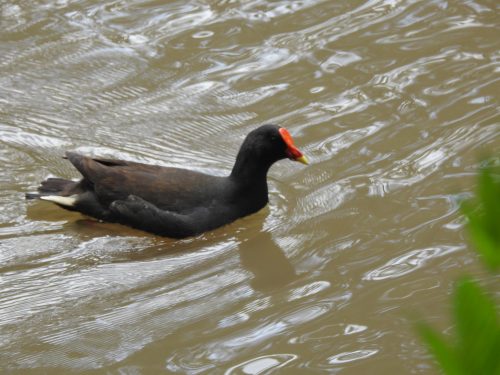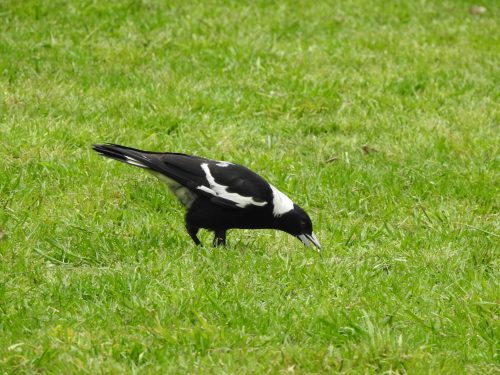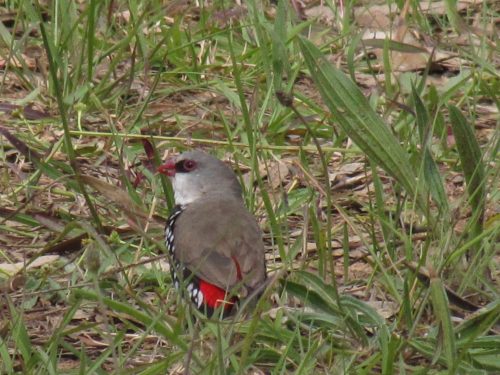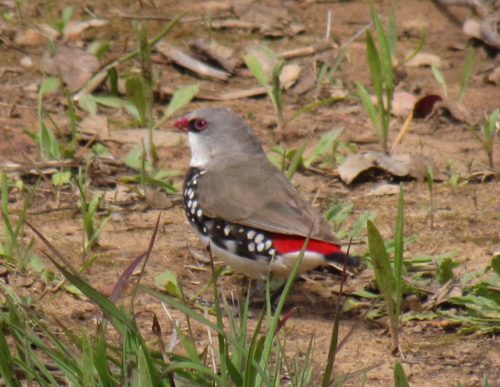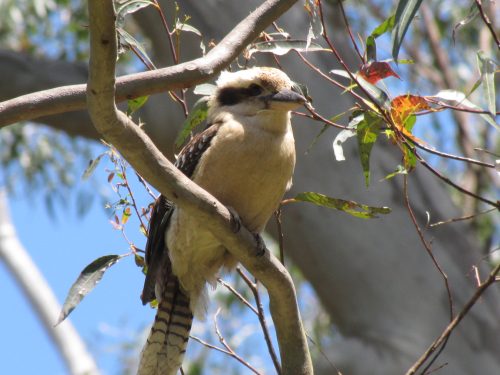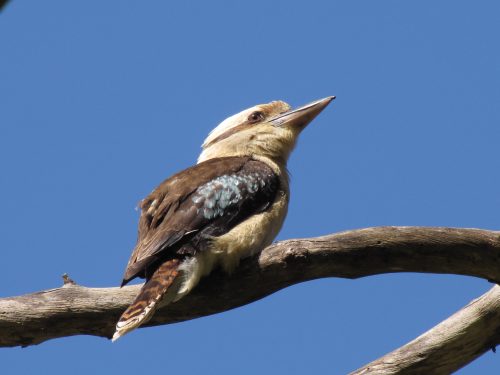Some Birds of the Lane Cove National Park
Over recent days I have posted some photos and articles about some of the birds I saw and photographed last month on a visit to the Lane Cove National Park in Sydney. I have visited this park on many occasions over recent years because it is only about a ten-minute drive from my son’s home.
Today I wish to post a compilation of some of my other photos taken on that visit in October. The first photo (above) is of a handsome looking Pied Currawong. This is a common and sometimes noisy bird in the park. Because of its loud, forest-penetrating call and its large size, it is quite conspicuous. At home in Murray Bridge, SA, I have the Grey Currawong as a regular visitor to my garden. Although it is also a prominent bird, it lacks the stark colours of the Pied variety.
The quiet and unassuming Black-faced Cuckoo-shrike is another bird I have often seen in the national park. It quietly goes about its life without too much noise and fuss. Its quiet and lovely churring call is diagnostic. Although it is mostly coloured plain grey, in certain light conditions it can appear almost bluish. As a child growing up in rural South Australia I seem to remember that this species was called a ‘blue jay’ while the White-winged Chough was a ‘black jay.’ That makes a lot of sense. The Black-faced Cuckoo-shrike is another regular visitor to my home garden.
On my visit to the Lane Cove National Park last month I was surprised by the lack of water birds along the river. I saw a solitary Little Egret, several Pacific Black Ducks and about three Dusky Moorhens, one being shown in the photo above. I also saw several groups of Australian Wood Ducks along with a few ducklings but nothing else. No cormorants, coots, Purple Swamphens or other species of duck.
Throughout the Lane Cove National Park, one can also observe the black-backed sub-species of the Australian Magpie. This is the common magpie around the Sydney area. At home in Murray Bridge SA, I have the White-backed Magpie as a resident breeding species in my garden. While there are magpies throughout the Sydney region, they are nowhere near as common as I am used to in the rural areas of South Australia. That is a pity because so many people are missing out on hearing the beautiful song of the magpie.
My last photo today is of one of the most loved Australian Birds, the Laughing Kookaburra. Instantly recognised by most people, enjoyed by many upon hearing its hearty laughter, it is one of our iconic, much-loved national symbols.
What most people do not realise is that this seemingly delightful bird species has a darker side to it. On more than one occasion I have seen kookaburras take sausages off of a hot barbecue plate, snatch food from the picnic table at my side, defecate on a picnic table from a branch above, and generally harass picnickers for free handouts of human food.
Please don’t feed them deliberately as human food is actually detrimental to their health. Please do not feed any of our native birds and animals; it is not good for them.
I’ll get off my soapbox now.
Good birding.
Trevor
P.S.: I would love to hear from my readers about their close encounters with our bird species. Use the comments section below.
Glen Alice in Capertee Valley
Earlier this week I wrote about my first visit to the Capertee Valley late last year. In general, this was a rather disappointing day of birding. I went with such high expectations, but I didn’t realise that I had underestimated the time needed to do this wonderful region justice. The road through the valley is an alternative route from Lithgow (north-west of Sydney) to Mudgee, though some of this section of the road is unsealed.
One really needs a full day to explore this area even superficially. Several days to a week would enable keen birders to really enjoy the delights of this valley. In this way, keen birders would be able to track down many of the wonderful birds of the valley. Along the route I took we noticed at least twenty signs pointing to Birdwatching Sites. Each would be worth stopping at for an hour or two. We only stopped at one, and that was in the small village of Glen Alice. This small settlement has a school, a community hall, an emergency fire station, an old church and several houses. Oh, I forgot – it also has a historic cemetery.
We went for a short drive along the only street before returning to the parking area near the old church. Here we stopped for afternoon tea. While we had our cuppa and some biscuits, I managed to do a little birding. Within seconds of getting out of the car, a solitary Diamond Firetail finch flew in and settled on the ground only a few metres from me. I was able to get a few quickly taken photos before it flew off again. These are the photos I have featured today.
Within the next half hour, I made quite a nice little list of birds seen but didn’t get any more photos – well, not any that are worth showing here. The following species were either seen or heard:
- Grey Butcherbird 1
- Noisy Miner 8
- Diamond Firetail 1
- Australian Raven 4
- Australian Magpie 4
- Red Rumped Parrot 2
- White-plumed Honeyeater 5
- Willie Wagtail 2
- Sacred Kingfisher 1
- Little Black Cormorant 1
- Hooded Robin 1
- Rainbow Bee-eater 2
- Superb Fairywren 2
- Crimson Rosella 2
- Australian Wood Duck 5
- Magpie Lark 2
- Rufous Whistler 1
- Black-faced Cuckoo-shrike 1
- Fuscous Honeyeater 1
Several kilometres out of town in the locality known as Bogee, I added the following species:
- Grey-crowned Babbler 3
- Yellow-rumped Thornbill 3
Related reading:
Wildlife of Lane Cove National Park
Over recent years, my wife and I have visited the Lane Cove National Park just west of Chatswood in the heart of Sydney. We try to get there whenever we visit family living in Artarmon nearby. Despite being in the heart of a bustling part of the city, this park not only preserves some remnant bushland for all to enjoy, it also boasts a good range of wildlife. I am particularly interested in the birdlife – hence this website. I also take an interest in other forms of wildlife, as well as the plant life, an interest which flows over from my wife.
On a visit there last October, I managed a few photos of some of the resident birds, as well as some other wildlife. A few weeks ago I shared a photo of two Long-necked Turtles here. I have also written about the local Sulphur-crested Cockatoos and the Australian Wood Ducks I saw in the park.
One of the very common birds in this area is the Noisy Miner, shown in the photo above. This individual landed on the picnic table alongside where we were sitting. I guess it was looking for a handout of human food, just like the local Laughing Kookaburras and Brush Turkeys. Noisy Miners are certainly the most common of the Australian honeyeaters in this part of Sydney.
I have noticed on all of our visits to this park that the Eastern Water Dragon is a very commonly observed reptile in the park. I think that we have seen many of these lizards on every visit to the park. The one shown in the photo below was quite friendly and unafraid, coming up quite close to where we were sitting.
Further reading:
Surprising waterbirds of the dry country
Dry Country
I love the dry country we have here in Australia. Most of my birding has been done in areas of Australia which have an average annual rainfall of under 250mm (10 inches). Some of this country is marginal farming country, sometimes cereals, and often sheep and cattle. I grew up on such a farm and still cherish my childhood adventures in the mallee bushland near my home.
On the road again
Earlier this week my wife and I travelled from our home in Murray Bridge, South Australia, to Sydney. We are currently staying with my son and his family. The grandchildren love having us stay with them. At ages 7 and 4 they are already showing an interest in the birds they see in their garden, and in the parks they visit. My interest has rubbed off on them.
Missing out
The car journey from home to Sydney is over 1300km, two long days of driving. In future, we think we might take three or four days to get here, stopping more frequently at the many interesting places along the way. There are many national parks, reserves, botanic gardens and bushland on this route and we just have to drive right on by, often with a groan of despair at what we might be missing.
Hay Plains
One of the places we drive through is the large rural town of Hay, located on the banks of the Murrumbidgee River. The birding along this river can be excellent. But before we get to Hay we have to pass through about 130 kilometres of the Hay Plains, a dry region consisting of few trees, much saltbush and some grassland. I find this drive to be fascinating because it often reveals odd collections of birds. On one trip we saw hundreds of Emus grazing on the low vegetation. On another trip, after heavy rain in that area, we saw thousands of ducks, mostly Australian Wood Duck and Grey Teal. They were taking advantage of the long stretches of water still lying along the edges of the highway.
Surprising Waterbirds
As we travelled along at 110kph my wife suddenly pointed out an interesting sight. It was a gathering of dozens of waterbirds: Australian Pelicans, White Ibis, Straw-necked Ibis and Yellow-billed Spoonbills. Harassing all of them from only several metres overhead was a Swamp Harrier. As we rushed by I didn’t have time to take in the presence of any other birds. I am sure that if we had had the time to stop, I would have recorded several species of ducks, perhaps coots, swamphens, egrets, herons and lapwings, cormorants, and maybe even some crakes and rails.
Irrigation
This was a very surprising collection of birds for what is essentially very dry country. The reason for their presence is explained by the presence of wide irrigation channels. The water is pumped from the nearby Murrumbidgee River into a series of channels, some of which are 5 or more metres wide. The water is then used to either flood irrigate large expanses of land, or pumped through long, overhead sprinkler systems. This area grows large amounts of hay, wheat and cotton, all irrigated from the channels. The fact that this also provides a perfect environment for numerous birds is a pleasant by-product. Further east there are large expanses of fruit orchards as well.
Further reading:
- Australian Pelicans overhead
- White Ibis at Dubbo Zoo
- Straw-necked Ibis Adelaide Zoo
- Yellow-billed Spoonbills and the birth of a birder
A very short birding trip in Peterborough
Last week we spent several days visiting family in Peterborough in the mid-north of South Australia. The main focus of this trip was a belated Christmas family get together. My son’s family who were over from Sydney for a few weeks was the main focus, but it was also great to catch up with family members on my wife’s side of the family.
The weather was far too hot to do anything other than casual birding in the back yard. The only interesting sighting over the four days was a solitary Little Eagle soaring majestically overhead early one morning. The Peterborough area is an interesting region from a birding point of view. While many of the species seen further south are present, one can also see some of the more arid region birds around the town and in the nearby farming areas. This is about as far south as some of these arid dwelling birds venture.
One spot I always try to check out when visiting Peterborough is Victoria Park. This park, next to the town’s lovely swimming pool and caravan park features an artificial lake (see photo above). On and around this lake I have recorded quite a good range of water birds, one of the few spots in the region with enough water to sustain a small population of such species.
On this occasion we were actually on our way home. We left early to beat most of the heat of later in the day. I only drove though the park and didn’t actually stop. I guess that our visit was no longer than 2 minutes – if that. During that short time I saw the following species:
- Apostlebird
- White-winged Chough
- Australian Magpie
- Black-tailed Native-hen
- Pacific Black Duck
- Australian Wood Duck
- Mallard
- Australian Magpie Lark
- Crested Pigeon
- Galah
- Red Rumped Parrot
- Red Wattlebird
- Little Raven
It is not a long list but it does contain two interesting sightings.
Apostlebird
While Apostlebirds are quite common in the eastern parts of Australia, they are relatively rare in South Australia. They can only be seen in a handful of places. I have recorded them in the following locations:
- Taplan (SE of Loxton),
- Gladstone (mid-north of SA),
- Laura (just north of Gladstone)
- Stone Hut (just north of Laura)
- Appila (north of Gladstone)
- Peterborough (various locations around the town and district)
- Dawson Gorge (NE of Peterborough)
Several other locations have been reported by other birders in recent years. Peterborough is one of the more reliable spots for this species in South Australia. Over recent years I have seen the species in at least five spots around the town. You can read more about this species – go to the further reading section below.
Black-tailed Native-hen
On my recent visit to Victoria Park in Peterborough I saw about 5 Black-tailed Native-hens. I have seen this species on quite a few visits to this park. While the species is not rare it is unusual to see them in such a dry region as this. I suspect that these birds may actually be a resident breeding species. In some places, if the conditions are right, they can breed rapidly and within a short space of time number in the hundreds and even in the thousands. On previous visit to this park I have seen 20 – 50 birds.
Further reading:
- Apostlebirds in Peterborough
- Apostlebirds by the dozen
- Apostlebirds at Taplan in the Murray Mallee
- Apostlebirds in South Australia
